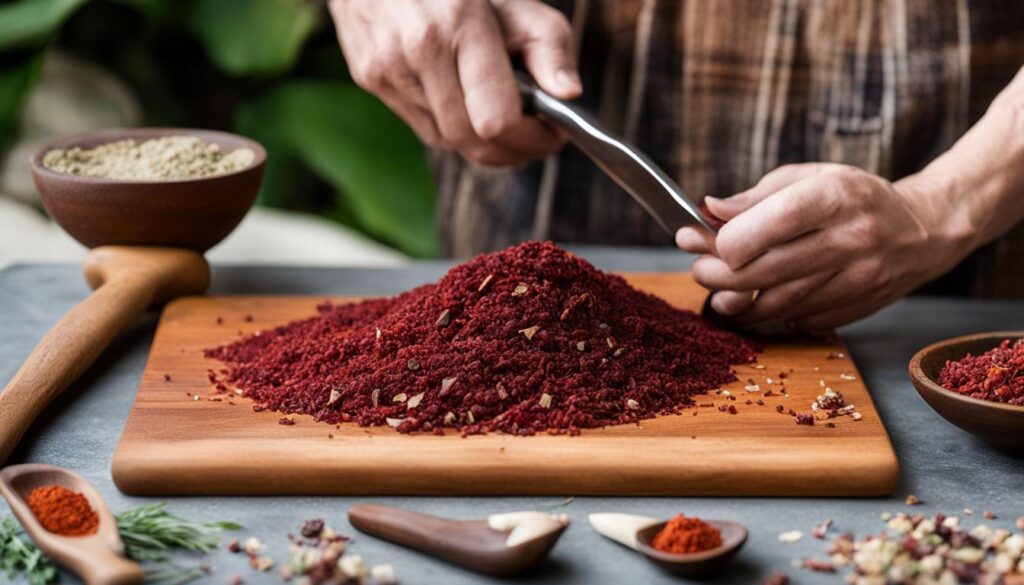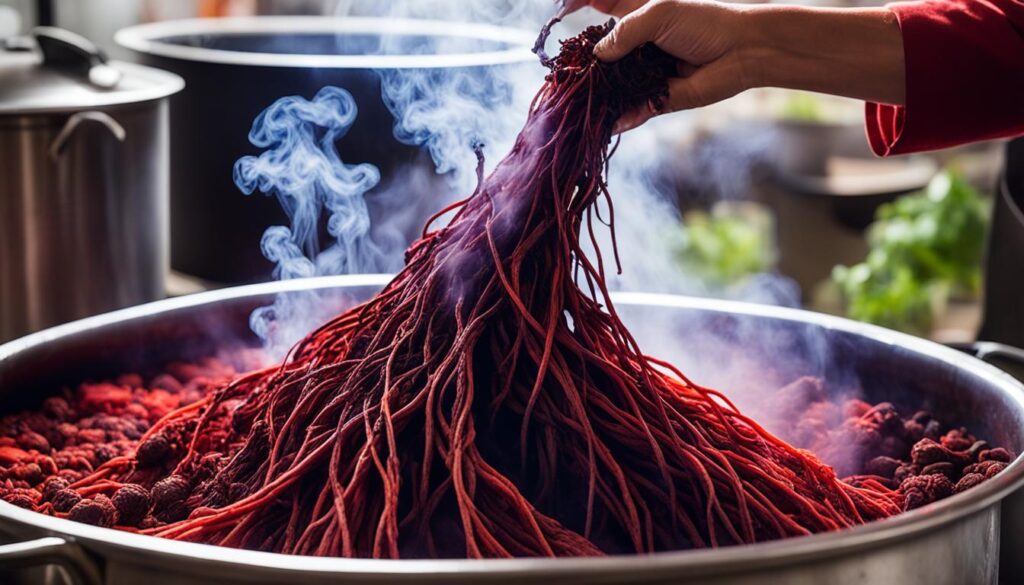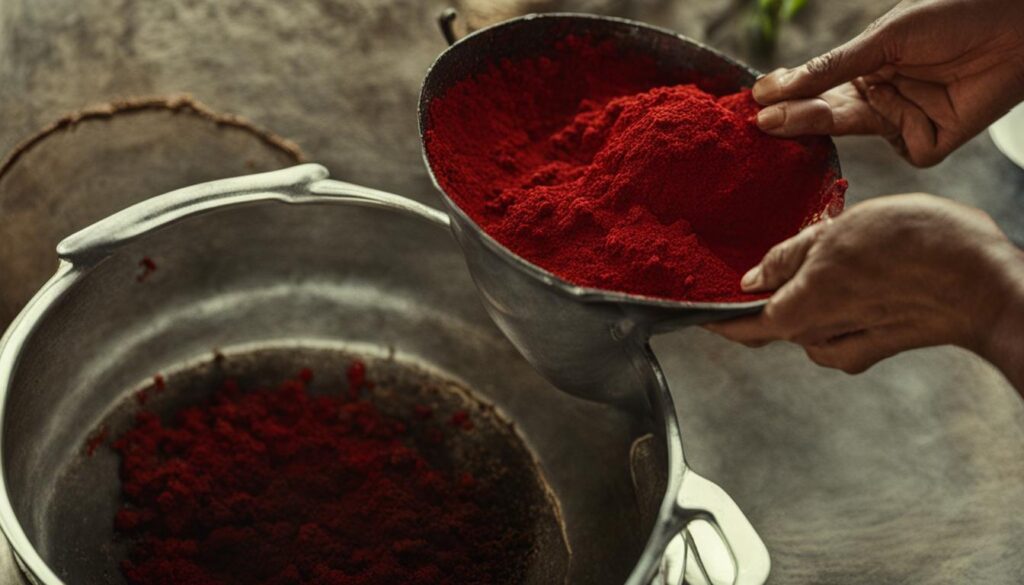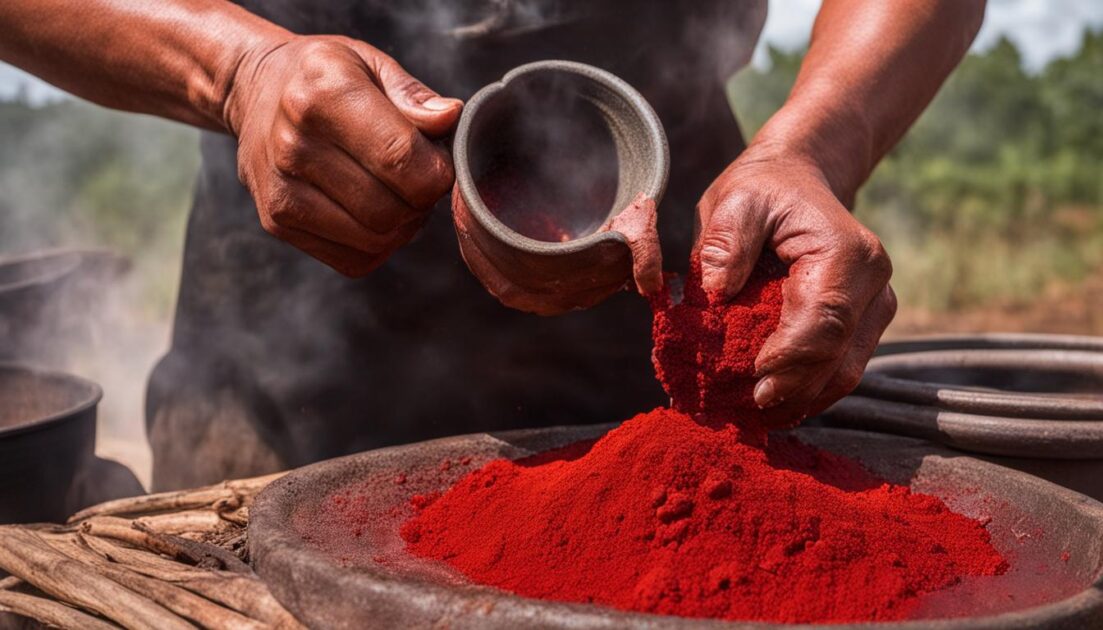Madder root, scientifically known as Rubia tinctorum, is a versatile plant that can be used to create a strong red dye. If you’re interested in exploring natural dyeing techniques, madder root is a great option to start with. In this step-by-step guide, I will walk you through the process of making madder root dye from scratch, right from harvesting the roots to dyeing your fabric or yarn.
Madder root has a rich history and was once used to dye the uniforms of the British Red Coats. It is a perennial plant that can grow up to 100cm tall and features slender stems covered with short prickly leaves. The small bell-shaped flowers are green/yellow in color, while the seeds dry out in the late autumn. Madder root can be propagated from seed, root, and shoot divisions, and germination typically takes 2-3 weeks.
Key Takeaways:
- Learn how to prepare madder root for dyeing.
- Discover the step-by-step process of dyeing with madder root.
- Explore tips for achieving different shades using madder root.
- Understand the storage and reusability of madder root dye.
- Consider the sustainability and ethics of madder root dyeing.
How to Harvest and Prepare Madder Root
To harness the vibrant dyeing power of madder root, it is essential to properly harvest and prepare the roots. Follow these steps to ensure the madder root is clean and ready for dyeing:
- Harvesting Madder Root: Lift the roots from 3-5 year old plants in the spring or autumn. This period ensures that the roots have reached maturity and are rich in the desired dye compound.
- Thorough Root Washing: After harvesting, wash the madder roots thoroughly but carefully. Begin by allowing the roots to dry on a sunny day, which will make it easier to remove excess soil. Then, gently brush off any remaining soil using a soft brush.
- Leaching Unwanted Pigments: Soak the washed madder roots in hot water for about an hour. This soaking process helps leach out any unwanted pigments or impurities that may affect the color outcome during dyeing.
By following these steps, you can ensure that your madder root is clean, free from debris, and prepared to yield vibrant, high-quality dyes.

Harvesting and Preparing Madder Root
| Step | Description |
|---|---|
| Harvesting Madder Root | Lift the roots from 3-5 year old plants in the spring or autumn |
| Thorough Root Washing | Allow the roots to dry, then gently brush off excess soil with a soft brush |
| Leaching Unwanted Pigments | Soak the washed roots in hot water to leach out unwanted pigments |
How to Dye with Madder Root
To achieve vibrant red hues in your dyeing projects, madder root is a fantastic natural ingredient to work with. Follow this step-by-step guide to learn how to dye with madder root and create stunning, earth-toned colors.
Gather Your Materials
To begin the madder root dyeing process, you will need the following materials:
- Dried chopped madder root
- Alum mordanted fiber or yarn
- Water
- Calcium carbonate
- Stainless steel bucket
Note: Mordanting your fiber or yarn with alum prior to dyeing helps the dye adhere better and results in more vibrant colors.
Prepare the Dye Bath
Start by dissolving the calcium carbonate in hot water. Add the solution to a cold water-filled dye bucket. Next, place the dried chopped madder root into the dye bucket, ensuring it is fully submerged. Let the madder root soak overnight.
Tip: Cover the dye bucket to prevent any dirt or insects from contaminating the dye bath.
Soak the Fiber
While the madder root is soaking, take your alum mordanted fiber or yarn and soak it in a separate container filled with water. This allows the fiber to absorb moisture and become fully saturated.
Heat the Dye Bath
Slowly heat the dye bucket, monitoring the temperature with a thermometer. Increase the heat gradually until it reaches 140 degrees F. It’s crucial not to exceed this temperature, as it can result in brown colors instead of the desired red shades.
Strain and Add the Fiber
Once the dye bath has reached the desired temperature, strain the madder root through muslin to remove any solids. Save this pigment for future use in creating paler shades.
Pour the strained liquid back into the dye bucket and carefully add the soaked alum mordanted fiber or yarn. Stir gently to ensure even dye penetration.
Maintain the Temperature
Keep the dye bath at a consistent temperature of 140 degrees F for one hour. This allows the dye molecules to bond with the fibers, resulting in long-lasting color.
Note: Avoid sudden temperature changes to prevent uneven dyeing.
Cool and Rinse
After the hour-long dyeing process, turn off the heat and let the dye bath cool overnight. This slow cooling process enhances color retention.
The following day, carefully remove the fiber from the dye bath and allow it to air dry. Rinse the dyed fiber thoroughly to remove any excess dye.

Enjoy the Vibrant Colors
Once dry, marvel at the beautiful red shades achieved through madder root dyeing. Experiment with different fiber types, dye concentrations, and dyeing times to create a variety of hues.
Remember, the natural dyeing process with madder root is both rewarding and sustainable. By using this ancient technique, you can produce beautiful, environmentally friendly colors that are sure to impress.
How to Dye with Madder Powder
If you prefer to use madder powder instead of chopped madder root, the dyeing process is slightly different. Start by calculating the appropriate amount of madder powder for your fiber, depending on whether you want a dark red or paler shade.
Mix the madder powder with warm water to create a runny paste. Then, add the paste to a dye bucket containing cold water. To enhance the dyeing process, dissolve chalk (calcium carbonate) in hot water and add it to the dye bucket.
Now, it’s time to prepare your mordanted fiber. Soak the fiber in the dye bath and slowly raise the temperature to 140 degrees F (60 degrees C). It’s essential to monitor the temperature using a thermometer to avoid overheating, which can result in brown colors instead of vibrant reds.
Maintain the temperature at 140 degrees F for about an hour, allowing the dye to penetrate the fiber thoroughly. Afterward, turn off the heat and let the dye bath cool overnight. This extended period allows the dye to fully bond with the fiber.
When the dye bath has cooled, remove the fiber from the bucket and allow it to dry. Once dry, rinse the fiber to remove any excess dye, and then wash it to ensure the color is set.
By using madder powder, you can achieve beautiful and vibrant red shades in your dyeing projects. Experiment with different amounts of powder and fiber types to find the perfect combination for your desired results.

Tips for Dyeing with Madder Powder:
- Calculate the appropriate amount of madder powder for your desired shade.
- Mix the powder with warm water to create a runny paste.
- Add the paste to a dye bucket containing cold water.
- Dissolve chalk (calcium carbonate) in hot water and add it to the dye bucket.
- Soak your mordanted fiber in the dye bath and slowly raise the temperature to 140 degrees F.
- Maintain the temperature at 140 degrees F for an hour.
- Turn off the heat and let the dye bath cool overnight.
- Remove the fiber from the dye bucket, dry it, rinse it, and then wash it.
Tips for Achieving Different Shades with Madder Root
Madder root dye is versatile and can produce a wide range of shades by using various modifiers. To achieve more orangey shades, you can dip your fibers or fabric in a citric acid solution or water with vinegar after dyeing. This modifier gives a vibrant and warm tone to the final result.
Adding a copper modifier to the dye bath can result in beautiful salmon shades. Copper modifies the dye and creates a unique color variation that adds depth and richness to the final product.
If you prefer a duller red or brown color, introducing an iron modifier can achieve this effect. Iron has an oxidizing effect on the dye, creating more earthy and muted tones.
For those who desire a shift towards pink shades, using an alkaline modifier in the dye bath can produce stunning results. This modifier changes the pH level of the dye, altering the color outcome.
It is important to consider that different fibers may react differently to madder root dye. Animal fibers like wool and silk tend to take up the dye better than cellulose fibers like cotton. Experimenting with different fiber types and modifiers can help you achieve the desired shades and variations.
Comparison of Madder Root Dye Shades
| Shade | Description |
|---|---|
| Red | A vibrant and bold shade of red, reminiscent of the color of ripe cherries. |
| Orange | A warm and radiant shade with hints of red and yellow, resembling the color of a sunset. |
| Salmon | A delicate and subtle shade of red with a touch of orange, resembling the color of salmon flesh. |
| Brown | A earthy and muted shade of red, reminiscent of the color of dried autumn leaves. |
| Pink | A soft and feminine shade with a hint of red, resembling the color of cherry blossoms. |
Storage and Reusability of Madder Root Dye
When it comes to storing unused madder root dye, proper handling is key to preserving its quality for future use. By following a few simple steps, you can ensure that your dye remains viable and ready for reusability.
If you find yourself with leftover madder root dye, store it in a glass jar to maintain its freshness. It is recommended to keep the jar in the fridge or freezer to extend its shelf life. However, it’s essential to check for any unusual odors or growth of fungi before using the dye. If you notice any signs of spoilage, it’s best to discard the dye to avoid compromising your dyeing results.
When you’re ready to reuse the madder root dye, a double boiler method can gently warm it up without overheating. This technique helps maintain the dye’s integrity and ensures optimal performance during the dyeing process.
The dye bath from madder root can often be reused multiple times, with each extraction resulting in progressively paler shades. To reuse the dye bath, it’s important to reheat it and add more fibers or fabric for subsequent batches until the dye is fully exhausted.
Benefits of Madder Root Dye Reusability
The reusability of madder root dye brings several advantages to both the environment and the dyeing process itself. By repurposing the dye bath, you can minimize wastage and maximize the value of your dye materials. Additionally, reusing the dye bath allows for experimentation with various shades and intensity levels, adding versatility to your dyeing projects.
Not only is reusing madder root dye economically and environmentally beneficial, but it also highlights the sustainable nature of natural dyeing practices. By embracing the reusability of madder root dye, you contribute to a more eco-friendly and mindful approach to creating vibrant and unique colors.
Next, we’ll explore the sustainability and ethics of madder root dyeing, shedding light on the broader impact of this natural dyeing process.
Sustainability and Ethics of Madder Root Dyeing
Madder root dyeing offers a more sustainable and environmentally friendly alternative to synthetic dyes. Unlike synthetic red dyes that require the use of sulphuric acid, madder root dyeing relies on natural processes and does not contribute to harmful chemical pollution.
This dyeing method, however, is not without its challenges. It is a labor-intensive process that involves careful cultivation, harvesting, and preparation of madder root. The sourcing of madder root becomes crucial in understanding the overall sustainability of the dye. It is important to consider the cultivation practices and ensure that they align with eco-friendly principles.
While madder root dyeing is just one approach to natural dyeing, exploring other options can further enhance sustainability practices. For instance, using food waste for creating natural pigments can be a great way to minimize waste and promote an eco-friendly dyeing process. Adapting such practices can contribute to a more sustainable and ethical approach to dyeing.
FAQ
How do I harvest and prepare madder root?
To harvest madder root, lift the roots from 3-5 year old plants in the spring or autumn. Thoroughly wash the roots and allow them to dry on a sunny day before gently removing excess soil with a soft brush. Soak the roots in hot water for an hour to leach out unwanted pigments.
What do I need to dye with madder root?
For dyeing with madder root, you will need dried chopped madder root, alum mordanted fiber or yarn, water, calcium carbonate, and a stainless steel bucket.
How do I dye with madder root?
Dissolve calcium carbonate in hot water and add it to cold water in the dye bucket. Soak the madder root overnight in the dye bucket. Soak alum mordanted fiber or yarn separately. Slowly heat the dye bucket to 140 degrees F, strain the madder root, and pour the strained liquid back into the dye bucket. Add the soaked fiber and maintain the temperature for an hour before cooling overnight.
Can I use madder powder instead of chopped madder root?
Yes, you can use madder powder instead. Mix the powder with warm water to create a runny paste and add it to a dye bucket with cold water. Dissolve calcium carbonate in hot water and add it to the dye bucket. Soak the mordanted fiber in the dye bath and follow the same dyeing process as with chopped madder root.
How can I achieve different shades with madder root?
To achieve more orangey shades, dip the fibers or fabric in a citric acid solution or water with vinegar after dyeing. Adding a copper modifier can result in salmon shades, while iron can create duller reds and brown colors. An alkaline modifier can shift the shades to pink.
How can I store and reuse madder root dye?
Store unused madder root dye in a glass jar in the fridge or freezer. Reheat the dye bath using a double boiler method for reuse. The dye bath can be reused multiple times, with each extraction resulting in paler shades than the previous one.
What are the sustainability and ethics of madder root dyeing?
Madder root dyeing is considered more environmentally friendly than synthetic dyes as it does not require the use of sulphuric acid. However, madder root dyeing is labor-intensive and requires careful cultivation, harvesting, and preparation. Consider the source and cultivation practices of the madder root. Exploring other natural dye options, such as using food waste for pigments, can contribute to a more sustainable and eco-friendly dyeing practice.






